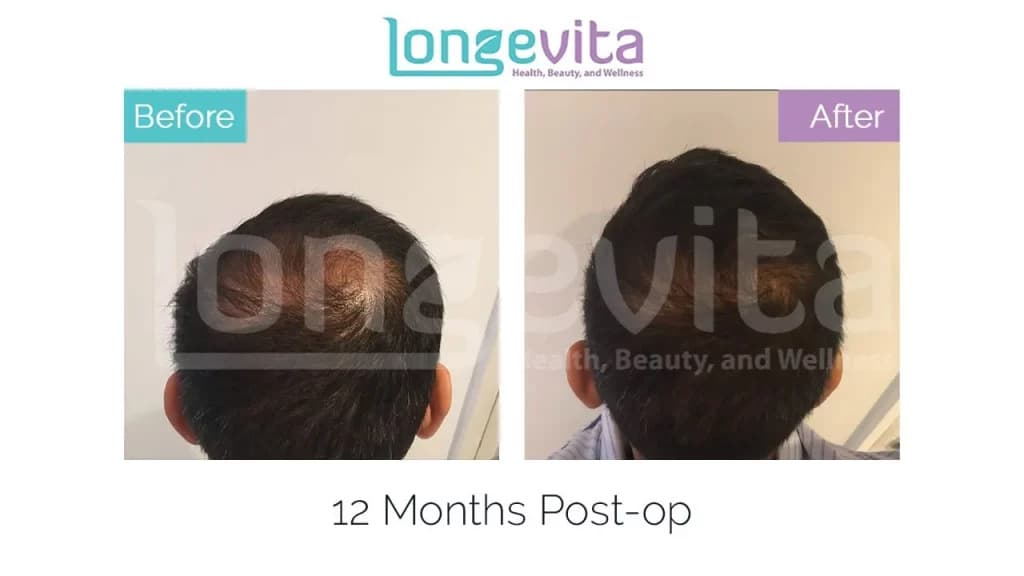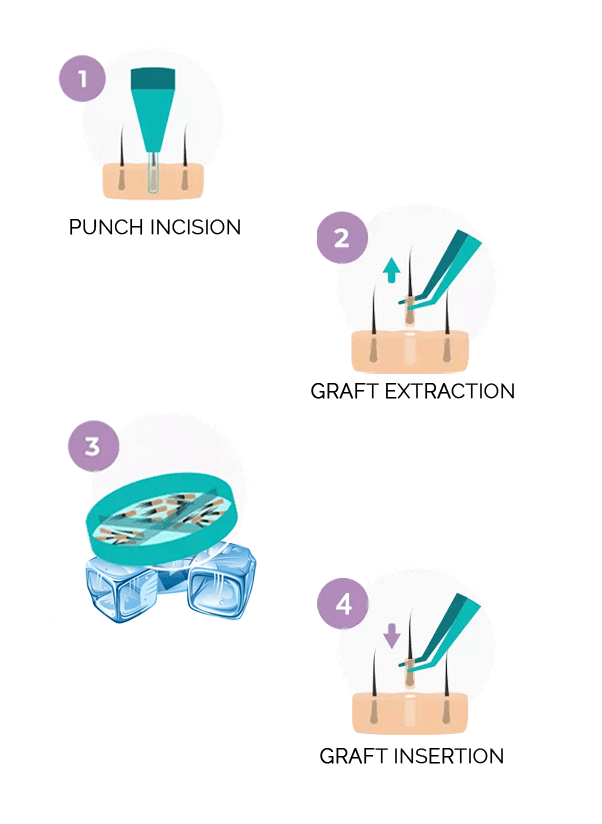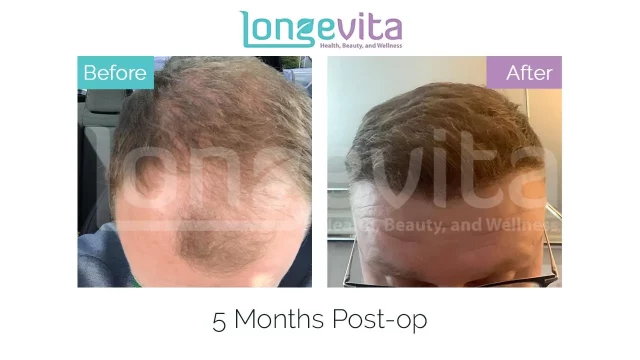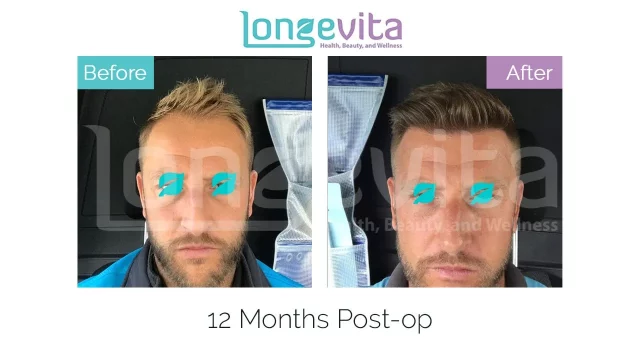Ice graft hair transplant uses the follicular unit extraction (FUE) technique for the excision and implantation of hair grafts.
However, in the ice graft technique, the follicles are not stored in the saline solution at room temperature.
Instead, the saline solution is chilled over plastic ice batteries, which improves the viability of the hair grafts before transplantation.
Overview Of Ice Graft Hair Transplant
After the extraction of the hair grafts from the donor area, they are placed in an isotonic solution for 5-6 hours, until the insertion part.
During that time, the hair grafts can experience trauma because of different reasons, such as temperature fluctuations, dehydration, and ischaemia (insufficient flow of blood), which can cause a lack of oxygen and cell energy depletion.
This has a direct impact on the viability of the grafts and their survival rate, which affects the overall hair density.
That is why it is important to ensure the provision of optimal conditions for the hair grafts in the storage solution.
One way to do that is by chilling the hair grafts, which slows down their metabolic rate, which means they need less oxygen and other nutrients. Cooling also has an anti-inflammatory effect.
Moreover, vitamins and antioxidants are added to the ice graft solution so that the hair follicles can thrive.
Thus, in ice graft hair transplants, the hair bulbs waiting for implantation can spend a long time outside of the body.
What Is The Cost Of Ice Graft Hair Transplantation?
The ice graft technique in Turkey is more affordable than in the UK and Europe.
This is because of the financing of healthcare through taxation.
Government subsidies further lower the cost of elective surgery.
The fees of technicians, surgeons, and nurses, along with the cost of operating room services and technology, are lower.
Currency exchange makes the treatment even more affordable for medical tourists, who can get hotel accommodation, transfer services, translators, and aftercare services with the surgery.
Who Can Have Ice Graft Hair Transplant and Why
Males and females experiencing hair loss because of androgenetic alopecia (pattern baldness) can undergo the ice grafts hair transplant technique.
If they have extensive balding regions along the hairline, top, and crow/vertex, the surgeon can harvest a large number of grafts using this technique.
It is also possible for patients with scarring alopecia to undergo this surgery.
However, the surgeon needs to do a scalp analysis to learn more about the vascularity and thickness of scars.
Other than that, people who have lost hair due to alopecia areata, traction alopecia, chemotherapy, and physical trauma can also undergo ice FUE.
In any case, the patient should have a high density of healthy hair in the donor area.
Am I Suitable For Hair Transplant?
What To Think About Before You Have Ice Graft Hair Transplant
Prior to surgery, ask the surgeon a few questions. Ask your surgeon about their experience with ice graft FUE and its complication rate.
Also, ask the surgeon whether classic FUE and ice grafts yield different hair graft survival rates. They will guide you about the surgery that’ll better suit you.

We will share the CVs and patient portfolios of the surgeons with you so that you can go through their qualifications, certifications, and registrations.
Moreover, you can request a virtual or face-to-face meet-up with a previous patient of the surgeon who had ice graft FUE.
How To Best Prepare for Ice Graft Hair Transplant?
You need to make the following preparations before undergoing ice FUE:
- Refrain from smoking, drinking alcohol, consuming tobacco products, and doing recreational drugs.
- Do not take any anticoagulants or supplements containing vitamin B and E.
- Remove any hair system that you’re wearing and/or wash off any hair fibre spray.
- Inform the surgeon about any active treatments that you’re undergoing.

Ice Graft Hair Transplant Procedure

The primary treatment comprises injecting local anaesthetics into the patient’s scalp. A motorized punch tool then extracts hair bulbs containing 1-4 hair follicles.
After that, the extracted grafts are placed in an isotonic saline solution with growth-enhancing factors that are chilled using ice batteries.
To this storage solution, vitamin B12 (biotin) is added, which ensures cell growth even outside of the body. And added antioxidants prevent cellular damage by free radicals.
This way, the to-be-transplanted hair roots are protected against trauma, ensuring a higher survival rate.
Since the grafts can stay out of the body for longer due to colder temperatures, ice graft FUE is particularly helpful when the patient needs 4,000-6,000 grafts.
A constantly fluctuating temperature can cause hair graft trauma. The temperature of the operating room can change in the 5-6 hours for which the grafts are out of the body.
However, the ice batteries ensure the grafts remain at the same temperature.
After the graft storage, the surgeon makes incisions in the recipient areas for placing the grafts. They will adjust to your body temperature, and their vascularization will begin in a few days.
The whole surgery can take 5-8 hours to complete. However, the total surgical time depends on the number of hair bulbs the patient needs to achieve the desired coverage and density.
Book A Free Consultation With Our Patient Consultants
We offer free consultations for patients across the UK & Ireland, so you can discuss your individual requirements with our specialists. Book A Free Consultation With Our Patient Consultants Today.
Recovery And Results Of Ice Graft Hair Transplant
Ice graft hair transplantation is an outpatient surgery. You may need to rest for 2-3 days following the surgery to deal with the side effects.
When you can go back to work depends on the nature of your work. If airborne dust and dirt are an occupational hazard, you might have to take some time off since it increases the risk of infection.
You cannot bend down either, as it can increase swelling. Side effects are, however, temporary and don’t last for more than a few weeks.
You can also lose your hair due to shock loss, but hair growth will start normally 3 months after the surgery. In 12-18 months, you can see the final results.
Aftercare Of Ice Graft Hair Transplant
Make sure that your head is elevated so that the swelling doesn’t worsen.
If you lie down straight, it can dislodge the grafts, especially in the crown/vertex region.
Other than that, stay out of the sun, gym, pool, and sauna.
Do not shower with hot or cold, and pressurized water.
Only use warm water to wash the scalp with the special shampoo and lotion given to you.
Be gentle with your scalp, stay hydrated, and eat foods that promote healthy hair growth.
Side Effects To Expect After Ice Graft Hair Transplant
An ice graft surgery can have the following side effects:
- Swelling/numbness in the forehead and eyelids
- Itchiness in the donor and recipient areas. It is normal, since it’s a sign of healing. Be sure not to touch the grafts.
- Bleeding from punch wounds and incisions
- Pain
- Folliculitis due to hair growth.
What Could Go Wrong After Ice Graft Hair Transplant
A complication of an ice FUE hair transplant is scalp infection. Your surgeon will prescribe antibiotics to you to prevent this from happening.
However, other factors like sweat, dust, and touching the scalp can also result in an infection. It can affect the survival of the transplanted grafts.
Physical trauma from hitting the head somewhere can also permanently damage the results.
What To Do If You Have Problems After Ice Graft Hair Transplant
You should get in touch with the aftercare team for help. You can message them online, call or email.
Alternatives to Ice Graft Hair Transplant
Depending on your personal preferences, you can consider undergoing a traditional FUE hair transplant over the ice graft one.
If you need less than 3,000 grafts, you also might be a suitable candidate for a DHI hair transplant.
However, if you have a weak donor area and cannot get a hair transplant, you can get scalp micropigmentation.
Other Procedures To Have With Ice Graft Hair Transplant
You can support the transplanted hair by getting platelet-rich plasma (PRP) therapy right after the ice FUE hair transplant.
Due to the effects of the local anaesthesia, you won’t feel pain when getting the injections. Certain proteins in PRP injections promote healing, ensuring a speedy recovery.
FAQ
Is ice FUE more expensive than traditional FUE?
No. The ice method uses the FUE technique for the extraction and implantation of grafts. Only graft storage differs from traditional FUE.
How many grafts can I get with an ice graft hair transplant?
The surgeon can harvest around up to 6,000 hair grafts in one session using the ice method.
What is the hair graft survival rate in ice grafts hair transplant?
The hair graft survival rate is around 95-98% in the ice FUE technique.
Do I need to shave my head for the ice grafts technique?
You can have an unshaven and shaven ice graft hair transplant. If you’re undergoing a shaven ice graft hair transplant, do not cut your hair for two weeks before the surgery. The hair will be shaved in the clinic on the day of the surgery.
Does the doctor have insurance that covers ice graft hair transplants?
Yes. The surgeon performing your ice graft hair transplant will have insurance against malpractice.
Reviewed and Approved by Trichologist Yaprak Yazan.




